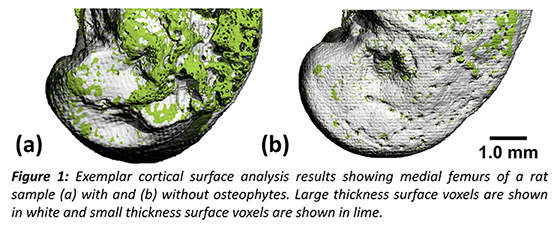Oral Presentation 33rd ASM of the Australian & New Zealand Bone & Mineral Society 2023
Quantification of abnormal cortical bone surface remodelling in preclinical models of arthritis (#32)
Abnormal bone remodelling at the outer cortical surface can lead to features such as bone erosion, cortical vascularisation, and osteophyte formation in arthritis. These pathological features disrupt the integrity of the cortical surface and lead to an abnormally coarse surface which can be observed using micro-computed tomography (microCT). However, quantifying these activities is challenging as commonly used measurements of the cortical bone (e.g cortical thickness) are insensitive to local remodelling activities at the surface. This study develops a novel approach, combining traditional image processing and empirical modelling, to automatically assess abnormal cortical surface remodelling through the observation of osteophytes in preclinical microCT datasets. MicroCT scans (SCANCO Medical) were obtained from previous rabbit and rat studies of osteoarthritis consisting of 8 rabbits and 11 rats [1,2]. For each animal, ACL transection was performed on the right knee and the left knee was a contralateral control. For each image of the joint, the cortical bone of the femur and tibia were segmented, and 3D thickness mapping was performed using a sphere-fitting distance transform [3]. A one-voxel-thick outer layer was segmented from the resulting thickness map, and the histogram empirically estimated by a series of statistical distributions. Parameters describing the best-fit distribution, determined with negative log-likelihood, were analysed to determine sensitivity to osteoarthritis and the presence of osteophytes using paired two-sided t-tests. Visual inspections reveal clustering of surface voxels with small thickness values around areas with osteophytes (Fig.1a), as compared to those without (Fig.1b). In both rats and rabbits, surface thickness optimally fitted to a Gamma distribution, whose shape parameter was sensitive to the presence osteoarthritis (p < 0.01) and osteophytes (p < 0.05). Future work will focus on characterising underlying biological processes of abnormal bone remodelling to gain insights into the emergence of the fitted Gamma distribution observed in this study.

- Stok, K. S. et al., PLOS One. 11(1): e0147564, 2016.
- Besler, B. A. et al., Bone. 146, 2021.
- Hildebrand, T. & Rüegsegger, P., Journal of Microscopy. 185, 1997.